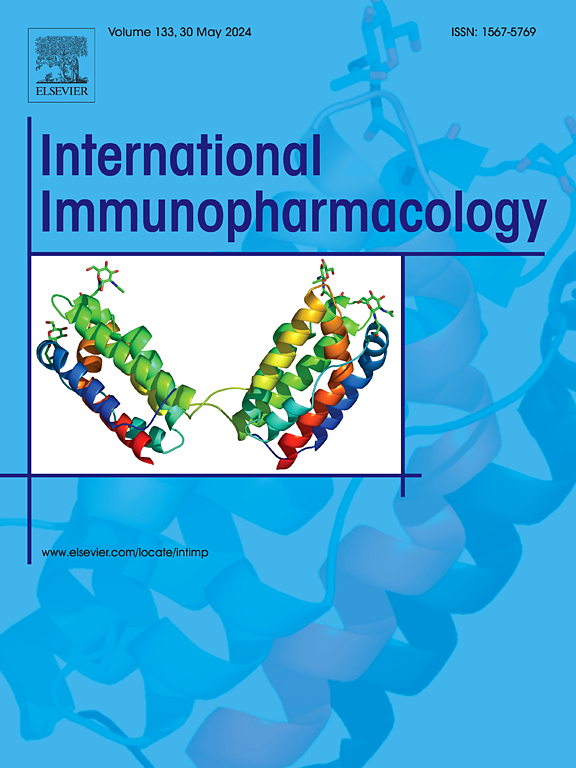下调Nr4a3通过调节Btg2减少氧化应激、线粒体损伤和细胞凋亡来减轻急性胰腺炎诱导的损伤
IF 4.7
2区 医学
Q2 IMMUNOLOGY
引用次数: 0
摘要
急性胰腺炎(AP)死亡率高,涉及氧化应激和线粒体损伤。核受体亚家族4组A成员3 (Nr4a3)和BTG抗增殖因子2 (Btg2)与线粒体损伤密切相关。本研究发现,cerulein诱导AP小鼠胰腺组织中Nr4a3表达上调。为了阐明Nr4a3的作用,我们将携带Nr4a3靶向短发夹RNA的腺相关病毒9 (AAV9)注射到胰管中。这种干预通过抑制胰酶激活来减少胰腺水肿、炎症浸润和腺泡细胞坏死。此外,Nr4a3敲低改善了胰腺腺泡细胞的线粒体功能,这可以通过线粒体膜电位增加、ATP生成增强和超氧化物水平降低来证明。它还通过抑制caspase通路的激活来抑制细胞凋亡。在体外,cck处理的胰腺腺泡细胞Nr4a3敲低可降低氧化应激,减轻线粒体损伤,抑制细胞凋亡,而Nr4a3过表达则加重细胞损伤。进一步的研究发现Btg2是Nr4a3的下游靶点。AP小鼠胰腺腺泡细胞Btg2表达升高,sirna介导的Btg2敲低可减轻cck诱导的细胞损伤。机制上,Nr4a3促进Btg2转录,从而促进胰腺腺泡细胞线粒体损伤,导致细胞凋亡。Btg2过表达逆转了Nr4a3敲低的保护作用。总之,我们的研究结果表明,下调Nr4a3通过调节Btg2发挥抗AP作用,为AP提供了潜在的治疗靶点。本文章由计算机程序翻译,如有差异,请以英文原文为准。

Knockdown of Nr4a3 mitigates acute pancreatitis-induced injury by modulating Btg2 to reduce oxidative stress, mitochondrial damage, and apoptosis
Acute pancreatitis (AP) has a high mortality, involving oxidative stress and mitochondrial damage. Nuclear receptor subfamily 4 group A member 3 (Nr4a3) and BTG anti-proliferation factor 2 (Btg2) have a close connection with mitochondrial damage. Here, we found that Nr4a3 expression was upregulated in pancreatic tissues of AP mice induced by cerulein. To elucidate Nr4a3's role, we injected adeno-associated virus 9 (AAV9) carrying Nr4a3-targeting short hairpin RNA into the pancreatic duct. This intervention reduced pancreatic edema, inflammatory infiltration, and acinar cell necrosis by suppressing pancreatic enzyme activation. Moreover, Nr4a3 knockdown improved mitochondrial function in pancreatic acinar cells, evidenced by increased mitochondrial membrane potential, enhanced ATP production, and decreased superoxide levels. It also inhibited cell apoptosis by suppressing the activation of the caspase pathway. In vitro, Nr4a3 knockdown in CCK-treated pancreatic acinar cells decreased oxidative stress, mitigated mitochondrial damage, and suppressed apoptosis, while Nr4a3 overexpression exacerbated cell injury. Further investigation identified Btg2 as a downstream target of Nr4a3. Btg2 expression was elevated in pancreatic acinar cells of AP mice, and siRNA-mediated Btg2 knockdown alleviated CCK-induced cell injury. Mechanistically, Nr4a3 promoted Btg2 transcription, thereby promoting mitochondrial damage in pancreatic acinar cells and leading to cell apoptosis. Btg2 overexpression reversed the protective effects of Nr4a3 knockdown. Overall, our findings demonstrate that downregulation of Nr4a3 exerts anti-AP effects by regulating Btg2, providing potential therapeutic targets for AP.
求助全文
通过发布文献求助,成功后即可免费获取论文全文。
去求助
来源期刊
CiteScore
8.40
自引率
3.60%
发文量
935
审稿时长
53 days
期刊介绍:
International Immunopharmacology is the primary vehicle for the publication of original research papers pertinent to the overlapping areas of immunology, pharmacology, cytokine biology, immunotherapy, immunopathology and immunotoxicology. Review articles that encompass these subjects are also welcome.
The subject material appropriate for submission includes:
• Clinical studies employing immunotherapy of any type including the use of: bacterial and chemical agents; thymic hormones, interferon, lymphokines, etc., in transplantation and diseases such as cancer, immunodeficiency, chronic infection and allergic, inflammatory or autoimmune disorders.
• Studies on the mechanisms of action of these agents for specific parameters of immune competence as well as the overall clinical state.
• Pre-clinical animal studies and in vitro studies on mechanisms of action with immunopotentiators, immunomodulators, immunoadjuvants and other pharmacological agents active on cells participating in immune or allergic responses.
• Pharmacological compounds, microbial products and toxicological agents that affect the lymphoid system, and their mechanisms of action.
• Agents that activate genes or modify transcription and translation within the immune response.
• Substances activated, generated, or released through immunologic or related pathways that are pharmacologically active.
• Production, function and regulation of cytokines and their receptors.
• Classical pharmacological studies on the effects of chemokines and bioactive factors released during immunological reactions.

 求助内容:
求助内容: 应助结果提醒方式:
应助结果提醒方式:


